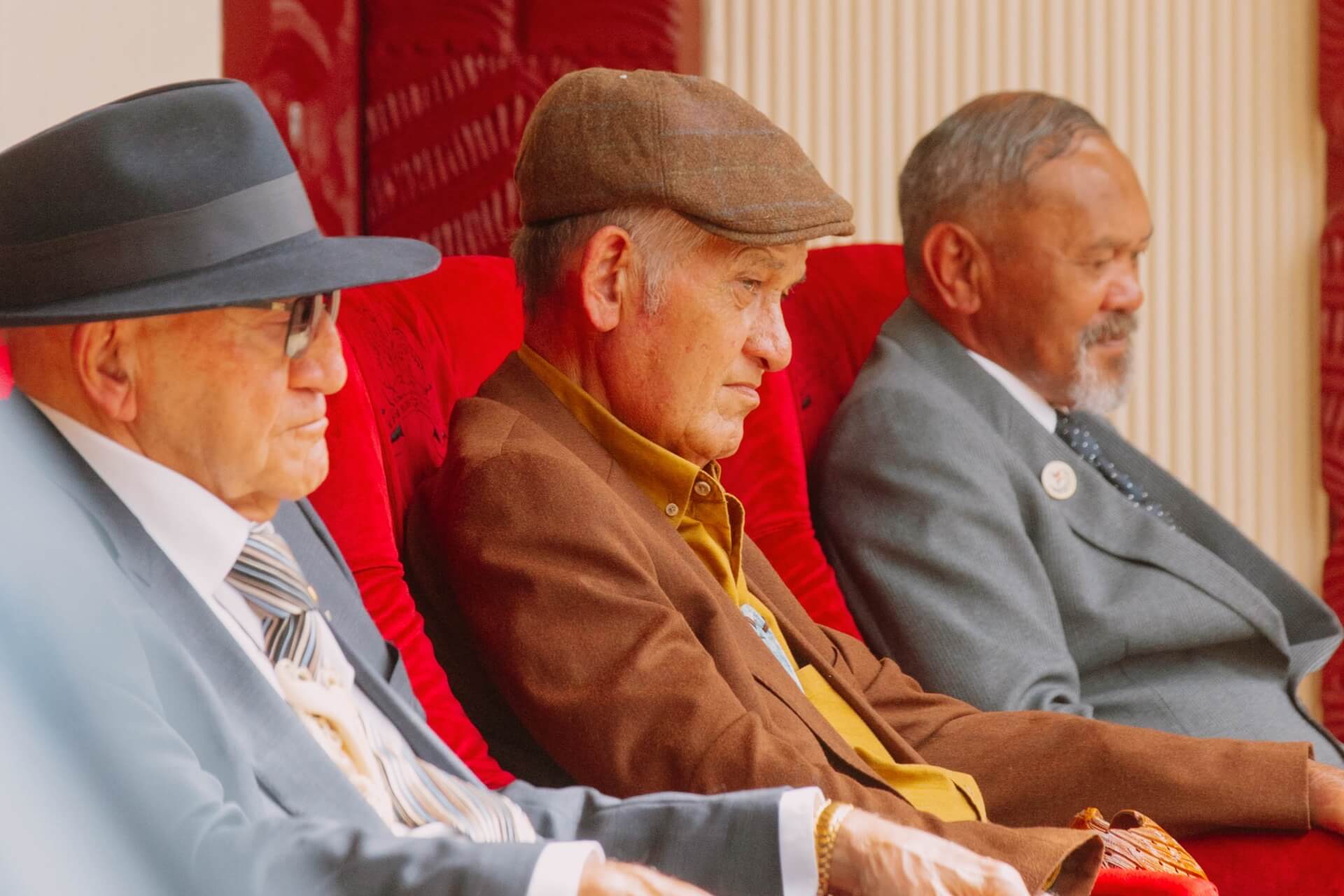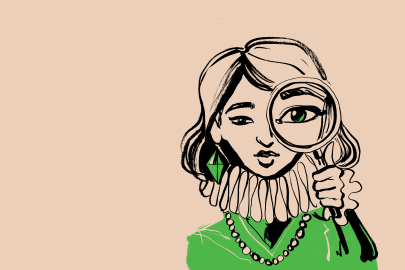Apr 23, 2024 Society
When we pull into the driveway, my dad is already there, brush in hand, finishing up a section of powder-blue paint on the side of the house as the radio blares from inside. Flanked by fruit trees, adjacent to the gates of the paa, this is the house my great-grandparents built. I don’t get here nearly enough — it’s a two-hour drive from my flat in Auckland, two and a half hours today in the Friday after-work traffic.
Tomorrow, according to news reports, an anticipated 3000 people will descend on Ngaaruawaahia for a 9am poowhiri. This little timber whare, so close in proximity to the marae, will be on full display to these crowds, hence my mum’s request earlier in the week: “Good thing you can do before hui is make sure the house looks good i.e. weed front garden.” Without changing out of my work clothes, I begin surveying the garden for weeds. It’s slim pickings, but wanting to be useful on this rare visit, I crouch down at the base of the tidy, rock-bordered flower bed on the front lawn and begin plucking whatever pernicious-looking shoots I can find.
Across the river, in the town centre, the two supermarkets are no busier than usual and the takeaway burgers we order later for dinner are prepared with miraculous speed. After dinner we make a short loop around the grounds of Tuurangawaewae, where immense white marquees have been pitched; each filled with hundreds of chairs in neat rows. With much of the preparation work seemingly complete, there’s just a smattering of people left testing sound systems and shuffling calmly between buildings, avoiding the incoming rain. Beyond the paa gates, it’s even quieter — there’s no traffic, no bustle of people and none of the buzz you might expect ahead of an event anticipated to draw such high numbers of people. The only indication of the day to come is in a grassy lot across the road: a posse of four parked campervans, plus a four-wheel drive with ‘Honour the Treaty’ emblazoned in white text on its front. Otherwise, it’s drizzly and quiet — almost eerily so. I wonder to myself whether tomorrow might be like one of those parties for which everyone RSVPs excitedly and then on the day decides to flake, relying on the thought that everyone else will show up.
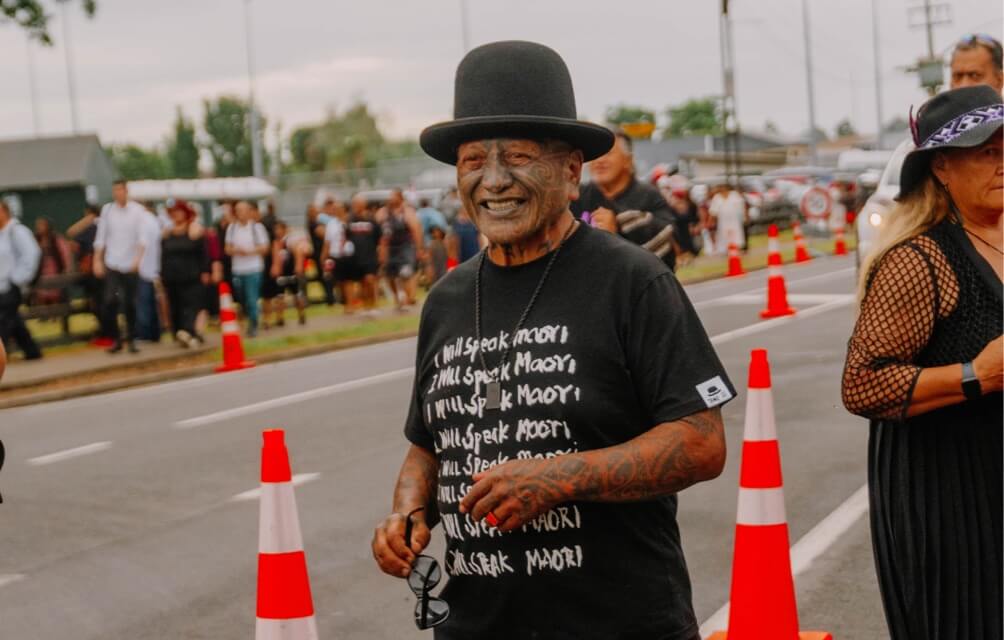
It’s still dark when I wake up the next morning to the sound of hushed conversation and laughter on the street outside. Peeling back the curtains, I squint, my eyes adjusting to the lamp-lit street. It’s three hours until the poowhiri begins, but there are clusters of people everywhere — all fully dressed for the day ahead, some walking briskly toward the marae, others gathered in groups, leaning against cars.
The quiet calm on the streets of Ngaaruawaahia the night before gave no hint of the movement taking place around the country. Uri from all corners of Aotearoa had gathered in the early hours of the morning to journey by bus — some travelling for five hours or more. Ngāi Tahu representatives had set out in the preceding days, journeying by road and ferry and then road again. Marae across the Waikato had hosted manuhiri, too. Others arrived that morning, with whaanau, friends or by themselves, in cars and vans, on motorcycles or horseback — the various flags of te ao Maaori flapping in the tailwinds behind them. Inside the closed gates of the marae, a sense of anticipation hung heavy: kaimahi were briefed, finishing touches put in place and cameras set up by news crews. Outside the long ponga fenceline, the road swelled with a who’s who of te ao Maaori: iwi and hapuu leaders, activists, artists, academics, social media celebrities and politicians from across the political spectrum (though mostly the left). Pootae aplenty. Hefty taonga carved from pounamu or bone. Tino rangatiratanga manicures. Linen suits. So much red, black and white. Kete. Korowai. Keffiyeh.
Kotahitanga happened on the dot. As those huge red gates swung open at 8.55, the resounding kaikaranga began, ushering in a crowd that seemed as though it would never end. Even when every seat and every square inch of standing room was filled, people still flowed in unabated. Additional gates were opened, too. “Mandela was big but not this big,” I overheard one person say of the South African president’s visit to the marae in 1995. In the end, it was estimated that around 10,000 people made their way through the gates on this single January day.
Mounting unease had paved the way for the enormous crowd. Kiingi Tuuheitia Pootatau Te Wherowhero VII issued a royal proclamation in early December, calling for a hui aa-motu or national gathering, aimed at “uniting the nation”. The proclamation didn’t come out of nowhere. Eleven days earlier, following the announcement of the final election results on 3 November and further weeks of negotiations, the National Party had entered into coalition agreements with Act and New Zealand First to form a new government. The coalition was committing to a raft of policies that sparked outcry for their wide-ranging blows to Maaori: the disbandment of Te Aka Whai Ora, the Maaori Health Authority; the repeal of Three Waters legislation; the removal of funding for cultural reports used in sentencing; the rollback of te reo Maaori use in the public service. And then, perhaps most odious of all, a promise by National to support Act’s Treaty Principles Bill (aimed at redefining the principles of the Treaty of Waitangi) to select committee. “There’s strong opposition to the Government’s statements on the Treaty of Waitangi which could undermine decades of hard-fought justice and equality for our nation,” Kiingi Tuuheitia’s proclamation read. “Now is the time for Kotahitanga and focusing on what we have in common.”
On 15 January, the Monday before the hui, Prime Minister Christopher Luxon met with Kiingi Tuuheitia at Tuurangawaewae alongside new Maaori development minister Tama Potaka. Over the course of about an hour and a half, concerns regarding the coalition government’s proposed policies, specifically those around te reo Maaori, were discussed. Luxon, who would not be attending the hui, told the media that the planned gathering was “not actually a political event per se. It’s actually not for politicians, we are not front and centre in those conversations.” While politicians may not have been front and centre of conversations on the day — these were driven by Maaori leaders beyond the Beehive — they were undeniably the central target of many stinging words.
After the morning poowhiri, legal scholar Dayle Takitimu delivered a keynote address that left no doubt as to whom the message of the hui was directed at. Takitimu said that the government’s actions had sown confusion and anxiety about Te Tiriti o Waitangi. Fuel had been added to the fire just the day before by way of a leaked draft memo from the Ministry of Justice outlining plans for Act’s Treaty Principles Bill, along with a comment that the proposal would be “highly contentious”. “[The parties in government] are Treaty illiterate,” Takitimu told the crowd. “An illiterate white supremacist is a nuisance, and a hoohaa, but an illiterate white supremacist in power is dangerous.”
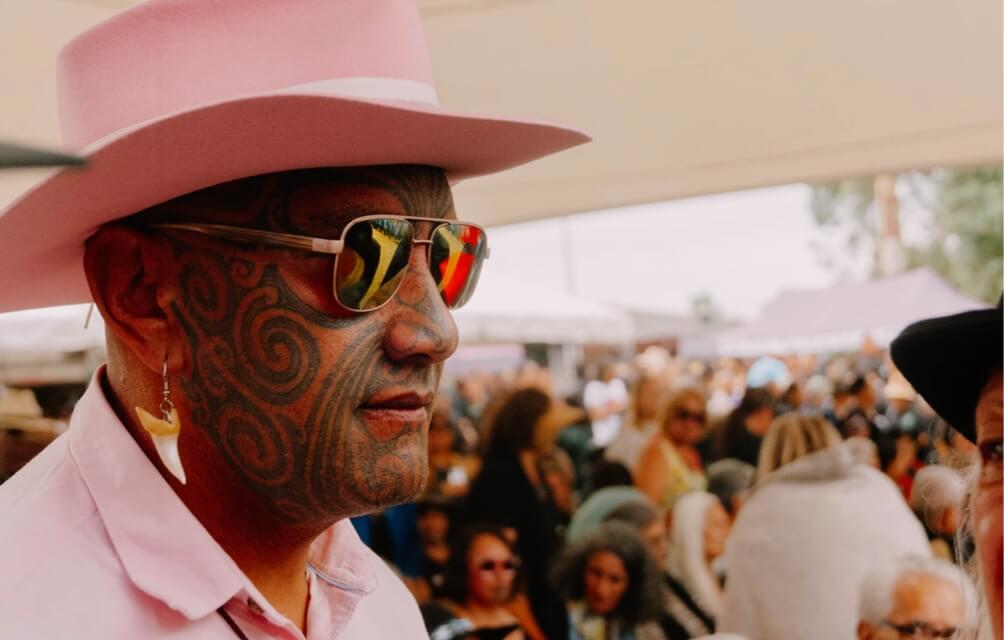
That these vast crowds would show up in the first weekend of the post-summer-holiday lull, and just six weeks after the invite was put out, braving oppressive heat and extravagant petrol prices, speaks volumes. Not only was it a demonstration of collective dissatisfaction with the government, it also highlighted the enduring legacy and influence of the Kiingitanga, and Tuurangawaewae marae as its base, in upholding this korowai of unity or kotahitanga.
To those immersed in the politics of te ao Maaori, this is emblematic of the Kiingitanga itself, which from its inception has been about kotahitanga as a form of resistance. Emerging during a particularly turbulent period in mid-19th century Aotearoa in the wake of the signing of the Treaty of Waitangi in 1840, the Kiingitanga responded to widespread land alienation, disputes over land sales to European settlers and breaches of the Treaty by the British Crown. Throughout the 20th and 21st centuries, the Maaori king movement served as a vital negotiating entity, advocating for Maaori interests to the Crown. And, given its experiences with government chicanery over the past 165 years, the Kiingitanga is uniquely positioned to sense when the New Zealand government might be, once again, up to its old tricks.
The concept of a unified Maaori identity, particularly in a political context, is relatively modern. As Taa Mason Durie wrote in 1998, “Before European contact, the word māori simply meant normal or usual. There was no concept of a Māori identity in the sense of cultural or even national similarities.” Instead, identity was primarily defined by hapuu and iwi affiliations, as well as connections with the natural environment. The signing of He Whakaputanga by 13 Ngāpuhi rangatira is often viewed as the starting point of a sense of collective national Maaori identity and a precursor to the kotahitanga movement, which aimed to cultivate a united front among Maaori and emphasise common features, as the British had long since done to their obvious strength. This movement took many forms, and one was the Kiingitanga.
In 1856, at a gathering in Puukawa on the shores of Lake Taupoo — part of a series of inter-tribal hui driven by concerns around land sales and their escalating problems — the decision to establish a Maaori king was made. This was an explicit adoption of European concepts of monarchy, but to be used in reverse, against the British. The thinking was that by establishing a monarch with status akin to that of Queen Victoria, Maaori would be able to engage with the newcomers on more equal footing.
Waikato rangatira Pootatau Te Wherowhero was chosen as the inaugural Maaori king. In 1858 he was officially crowned, with the central North Island tribes that supported him agreeing to relinquish control over their land to prevent individual rangatira from selling plots. Te Wherowhero’s ascension marked the formal establishment of the Kiingitanga movement, which sought to unite iwi Maaori under a single sovereign to halt land sales to settlers, cease inter-tribal warfare and foster the preservation of Maaori culture — a collective affirmation of mana motuhake.
Over time, the Kiingitanga took on the appearance of an alternative administration, with all the trappings — its own flag, newspaper, bank, currency, councillors, magistrates and law enforcement. Unsurprisingly, the Maaori deployment of monarchy to challenge the British, and the fact that it had been done with such efficacy, not to mention style, did not sit comfortably with the Crown. The unsettled British did everything they could to undermine and dismantle the power and influence of the Kiingitanga. In July 1863, the colonial governor George Grey issued a proclamation, “All persons of the native race living in the Manukau district and the Waikato frontier are hereby required immediately to take the oath of allegiance to Her Majesty the Queen”, before government troops invaded the Waikato. The next 10 months were marked by violence and dispossession — hundreds were killed; King Taawhiao, Pootatau’s son and the second monarch, was forced to retreat; and approximately 1.2 million acres of productive Maaori land was stolen by the Crown.
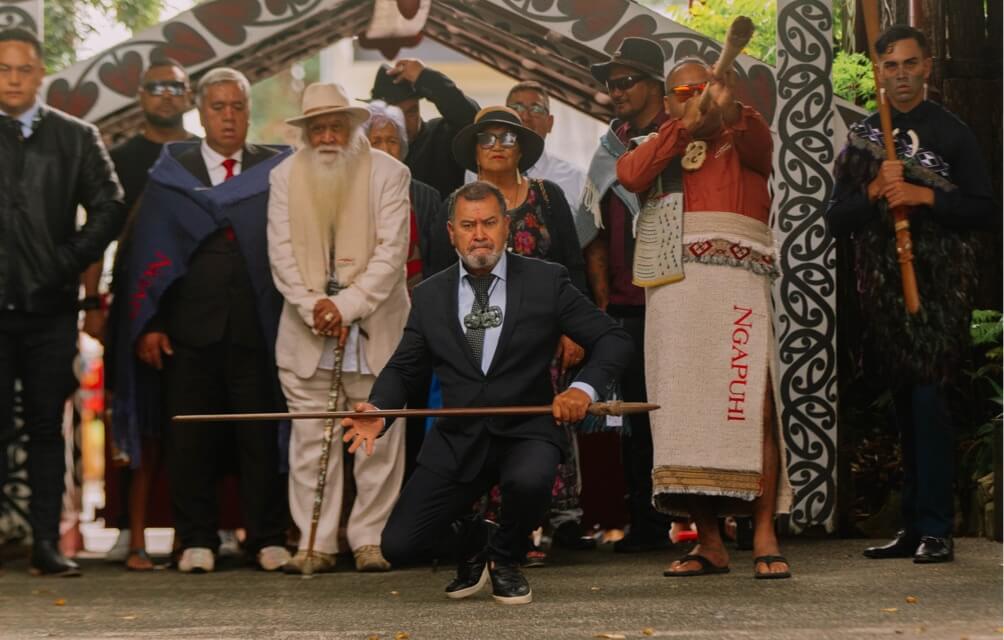
The day at Tuurangawaewae unfolded in a flash, a blur of activity, dialogue and searing heat. After speeches in the morning, the masses dispersed between five different break-out sessions, standing room only (if you were lucky to get close enough to hear). Despite accommodating more than three times the expected number of guests, the marae seemed to effortlessly contain the crowds. The logistics of it all were completely mind-boggling. “If you’re wondering how on earth we’re gonna conduct this hui, don’t worry, so am I,” Kiingitanga spokesperson Archdeacon Ngira Simmonds quipped from a podium early in the day.
Concessions had been made ahead of time; the usual post-poowhiri whakanoa, typically a sit-down affair with kai and kapu tii, was replaced by pre-packed boxes filled with sandwiches, fruit, slices and pottles of yoghurt — like marae-style bento, that were handed out by volunteer kaimahi, passed along the rows and then eaten by attendees listening to the panels of speakers. Kimiora, the wharekai at Tuurangawaewae, is accustomed to serving 1000 people in a single seating, but with so much to pack into the six hours, it wouldn’t have made sense to do so. Kotahitanga often means innovation, even by way of kai.
Tuurangawaewae, meaning ‘a place to stand’, and the largest marae in the world, stands as the epicentre of the Kiingitanga. Established during the 1920s and 1930s under the guidance of influential leader Te Puea Heerangi, a granddaughter of King Taawhiao, it arose from the aftermath of land confiscations and poverty, and was at the heart of the revitalisation of the Kiingitanga. Despite those origins in adversity, Tuurangawaewae remains an enduring symbol of independence, resilience and tenacity. This spirit is embodied by a dedicated volunteer base which has made possible the hosting of various annual events on the paa, such as Poukai, Koroneihana and the regatta, plus overseas dignitaries and monarchs. When the afternoon heat was at its most unbearable during Hui aa-Motu, the entire grounds of the paa seemed to be overcome by attendees, rangatahi to ruuruhi, holding Juicies. There was a chorus of collective slurping. More than a century of resistance, organisation and manaakitanga was expressed through the foresight to have thousands of Juicies at the ready.
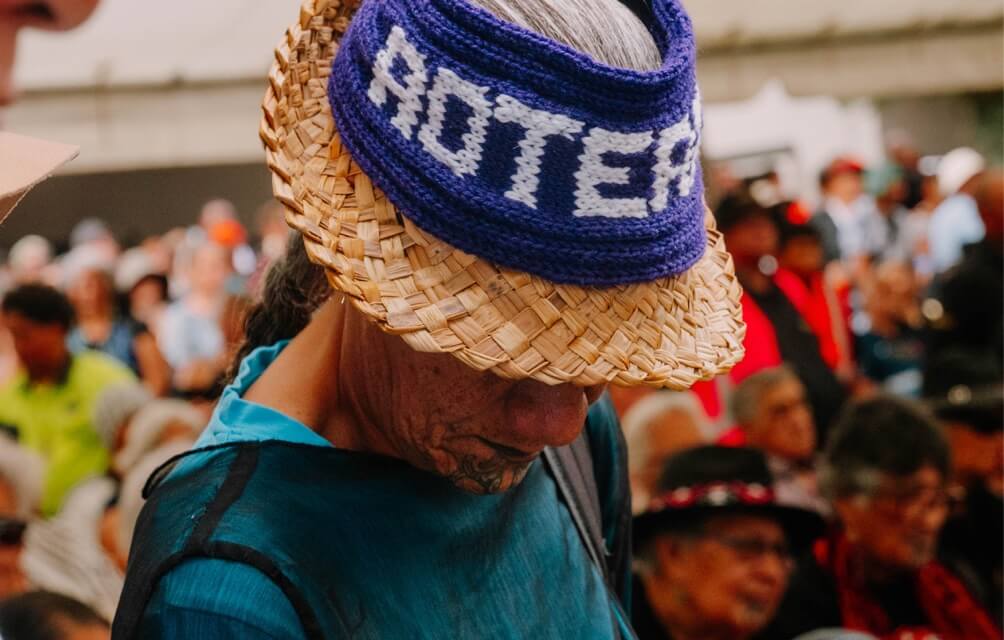
Maaori history following the arrival of the British has been punctuated by similar kinds of unifying hui, also sometimes referred to as meetings, conferences or ruunanga. The catalysts for these gatherings are almost always actions by the Crown that are perceived as unjust or detrimental to tangata whenua. In 2012, for example, Kiingi Tuuheitia called for a hui concerning Maaori water rights following a Waitangi Tribunal report indicating that the government’s partial asset sales programme would violate the Treaty of Waitangi. A thousand people, including representatives from the Iwi Leaders Group, the Maaori Council, the Federation of Maaori Authorities, major iwi, hapuu, the Maaori Women’s Welfare League and religious sects, converged upon Tuurangawaewae. Similarly, nearly a century earlier, in April 1907, 3000 Maaori gathered at Waahi (Huntly) to discuss, “the sufferings through injustice of the people of the Island of Aotearoa and Waipounamu” and “the Agreement of Queen Victoria with our ancestors in the Treaty of Waitangi”.
Parallels can also be drawn between Hui aa-Motu and the 1995 national Maaori hui convened at Hīrangi marae in Tuurangi. Initiated by Ngāti Tūwharetoa paramount chief Hepi Te Heuheu Tūkino VII, the hui aimed to coordinate a unified response to the government’s proposal for a capped budget (often referred to as ‘the fiscal envelope’) to settle Treaty of Waitangi claims. With more than 1000 attendees representing major tribes from both islands and various Maaori organisations, the hui yielded unanimous resolutions, reigniting demonstrations of Maaori collectivism in the face of the Crown’s bad behaviour. As Ranginui Walker wrote in the September 1994 issue of Metro, “The fiscal envelope has revived Maaori activism which has been dormant for almost a decade.”
Perhaps the most groundbreaking thing about Hui aa-Motu was its role in expanding existing coalitions between tangata whenua. New alliances emerged, indicating a flourishing sense of shared purpose within te ao Maaori — nothing brings people together like a mutual enemy. At the poowhiri, the presence of a large, impeccably dressed Ngāpuhi delegation, led by rangatira Hōne Sadler, reflected this evolution. While there is much nuance in the relationship, since the establishment of the Kiingitanga in 1858 Ngāpuhi have stood somewhat aloof from the project, maintaining their distinct identity and autonomy. Their participation this year signalled a significant shift.
And solidarity is a two- (or more) way street. Two weeks later, Kiingi Tuuheitia attended Waitangi celebrations along with a Waikato-Tainui contingent that filled seven buses, marking another unexpected departure from tradition. The Kiingitanga usually marks the day on home grounds. Speaking on behalf of hau kaainga, Sadler acknowledged Kiingi Tuuheitia’s presence and his efforts to unify Maaori. “Aotearoa is happy that you have returned to Waitangi. We must work together to find the solution to move forward,” he said. “Let us unify, let us mobilise under mana motuhake.”
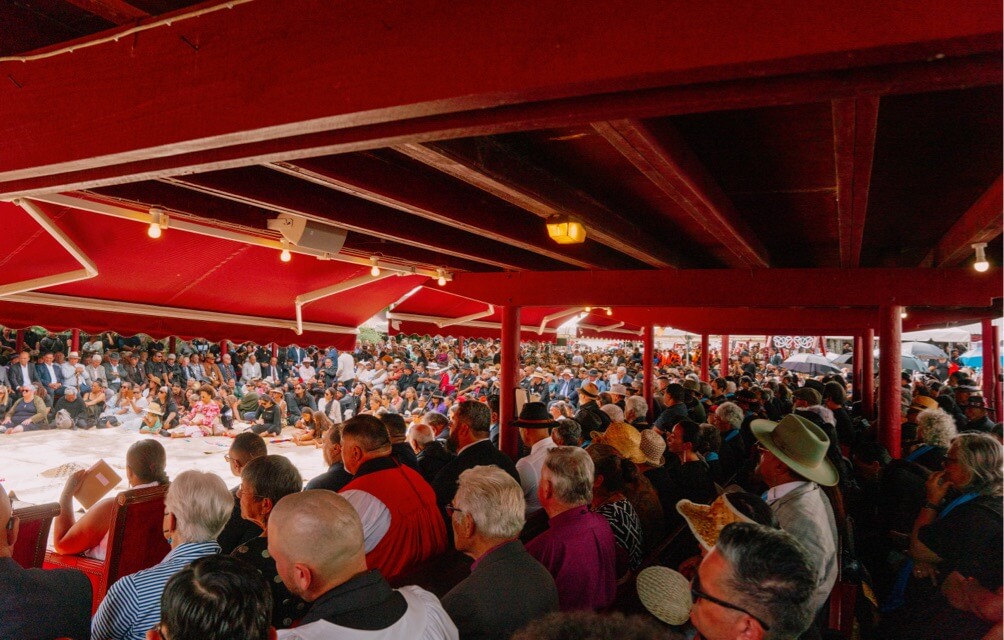
Even before Hui aa-Motu took place, the antagonistic tone taken by the incoming coalition government or “three-headed taniwha” sparked a flurry of action, with nationwide protests and multiple iwi filing court cases against the government. After the hui, the government’s plans continued to dominate the agenda — at Rātana the following week and Waitangi the weekend after. Still, there’s a sense that the government, for the most part, has dug its toes in on its approach. The curt disestablishment in February of Te Aka Whai Ora (designed to create better health outcomes for Maaori and give expression to Te Tiriti o Waitangi), just days before a scheduled Waitangi Tribunal hearing into the proposal, stands as particularly galling proof.
As we know from the history of the Kiingitanga and many other acts of resistance, it’s not the first time the government has been ruffled by Maaori. Nor is it the first time a New Zealand government has made the political calculation that they can throw Maaori under the bus and suffer few consequences. Yet, over the past two centuries, we’ve come to learn that government actions which inflict harm upon individual Māori also serve as a rallying cry to move as one. The momentum generated at Hui aa-Motu has continued to reverberate, with affirmations of mana motuhake emerging in the most unexpected corners: a viral video of high school students protesting David Seymour with a haka, the Hurricanes Poua team performing an opening-season haka criticising the government, the ubiquity of ‘Toitū Te Tiriti’ t-shirts by Melanie Tangaere Baldwin on the streets of Tāmaki Makaurau.
At the end of the hui, Kiingi Tuuheitia, in a familiar jovial tone, told the crowd, “The best practice we can do right now is be Maaori — Maaori all day every day. We are here, and we are strong.” Being Maaori at this moment in time, within this political landscape, means feeling contradictions: overjoyed that we care enough, and that we’re fired up enough, for kotahitanga to exist, but also enraged that we are compelled to come together yet again, with such urgency, to protect our basic rights. “Being Maori is hard, being Maori is sad, being Maori is to laugh, being Maori is to cry, being Maori is forever,” Ranginui Walker wrote in 1978.
At a surface glance, the objectives of the day might have seemed a little foggy. There were five different break-out sessions — Wellbeing of People Economy, Te Reo and Tikanga, Rangatahi, Treaty and Environment, and National Unity — each with panels discussing a range of complex and weighty topics. The number of people and limited timeframe meant that, logistically, there was no real forum for everyone to have their say, nor even a way for everyone to hear what was being said on stage. Then there was the largely unknown app, Whova, through which attendees were asked to register before the hui. Within the app, which garnered more than 5000 sign-ups, conversations splintered into various virtual forums that reflected just how nuanced and interconnected issues that matter to Maaori are.
The topics discussed in those forums ranged from establishing kaupapa Maaori rest homes to employment conditions, sustainable food production, iwi ventures in banking, the boycott, divestment and sanction movement against Israel, census data, voter turnout, constitutional reform and so on. With this breadth of issues to tackle, it would be easy to despair at the vast battlefront faced by tangata whenua — the work to be done stretches from the lofty heights of treaties and constitutional frameworks to the everyday corners of our lives. Rather than attempting to do the impossible — neatly packaging these complexities once and for all — Hui aa-Motu was about galvanising a sense of collective mauri and purpose, motivating Maaori to assert themselves as we move forward as one. Just showing up was the starting point.
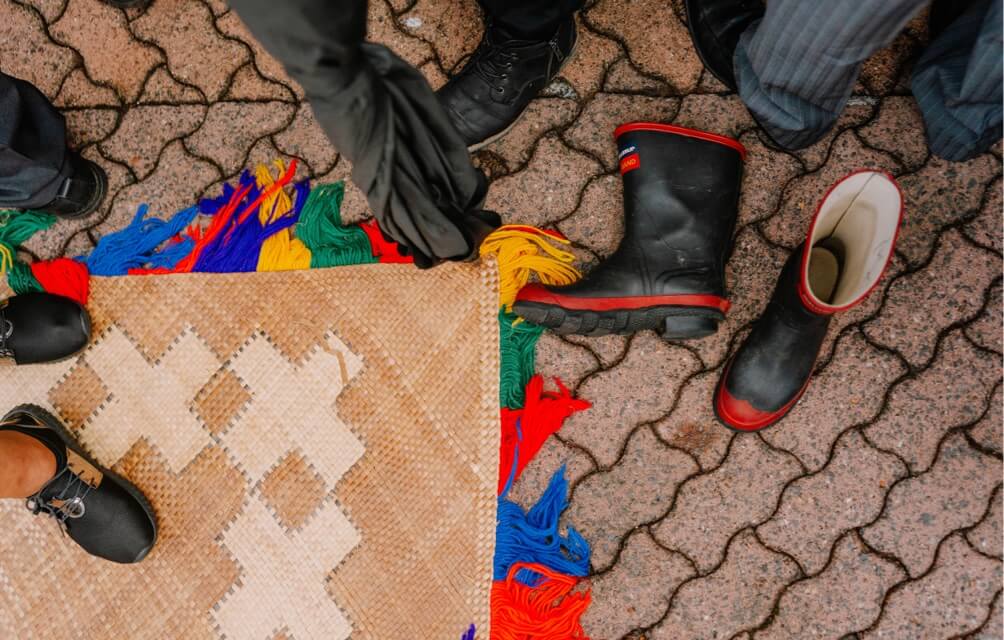
–
This story was published in Metro N°442.
Available here.


